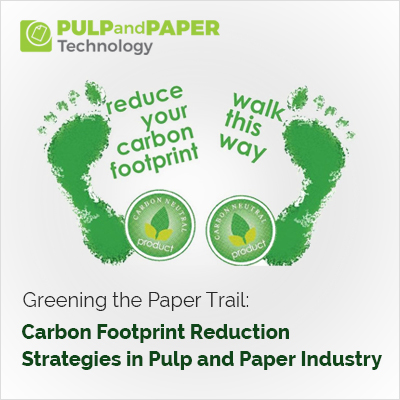Greening the Paper Trail: Carbon Footprint Reduction Strategies in Pulp and Paper Industry

Amidst an era marked by heightened environmental awareness, pulp and paper companies are making substantial efforts to reduce their carbon footprints and actively engage in sustainable business practices. This piece explores the inventive strategies and state-of-the-art technologies adopted by key players in the pulp and paper industry to assess, diminish, and offset carbon emissions. These initiatives align with the escalating focus on corporate sustainability goals, underlining the sector's commitment to environmental responsibility and progressive business practices.
1. Measurement Technologies:
The pulp and paper industry is increasingly embracing advanced measurement technologies to comprehensively assess and quantify its carbon footprint throughout the production process. Carbon accounting software and life cycle assessment tools play pivotal roles in this endeavor, offering companies a sophisticated means to accurately measure the environmental impact of their operations.
Carbon accounting software enables real-time monitoring and data collection, allowing for precise calculations of carbon emissions associated with different production stages. Simultaneously, life cycle assessment tools provide a holistic view, analyzing the entire life cycle of paper products from raw material extraction to manufacturing, distribution, and end-of-life.
These technologies empower companies to identify key areas contributing to their carbon footprint, facilitating informed decision-making for targeted emissions reduction strategies. By leveraging these advanced measurement tools, pulp and paper companies can not only gauge their environmental impact but also implement effective measures to enhance sustainability and align with corporate carbon reduction goals.
2. Energy Efficiency Initiatives:
Pulp and paper mills are proactively undertaking initiatives to enhance energy efficiency, bringing about a transformative shift in their operations with a simultaneous reduction in environmental impact. A primary area of concentration involves the integration of energy-efficient machinery and state-of-the-art technologies, aimed at optimizing energy consumption at various stages of the production process. By strategically redesigning processes, mills are actively streamlining their operations to minimize energy wastage, resulting in an overall improvement in efficiency. This concerted effort reflects a commitment within the industry to adopt cutting-edge practices that not only boost productivity but also contribute to a more sustainable and eco-friendly approach to paper manufacturing.
In addition, a noteworthy development involves the integration of renewable energy sources such as solar, wind, and biomass within the operational framework of pulp and paper mills. This deliberate strategy seeks to broaden the spectrum of energy resources while simultaneously reducing reliance on fossil fuels. Through the implementation of these initiatives, mills contribute not only to the mitigation of greenhouse gas emissions but also bolster their operational resilience and commitment to sustainability. This adaptation underscores the industry's dedication to embracing cleaner and more environmentally friendly energy solutions, aligning with global initiatives aimed at minimizing the ecological footprint of their activities.
This comprehensive commitment to enhancing energy efficiency highlights the industry's dedication to adopting cleaner, more sustainable practices, aligning with global endeavors to address and mitigate the impacts of climate change.
3. Sustainable Sourcing Practices:
Sustainable sourcing practices have become paramount in the pulp and paper industry, emphasizing the critical role of responsible forest management and certification programs in procuring raw materials. The industry recognizes the importance of ethical and environmentally friendly practices in harvesting wood fibers, and as a result, it is increasingly prioritizing sustainable sourcing. Responsible forest management involves practices that maintain or enhance forest health, biodiversity, and ecosystem services.
Certification programs, such as the Forest Stewardship Council (FSC) and the Programme for the Endorsement of Forest Certification (PEFC), are crucial in ensuring strict adherence to environmental and social standards. These certifications serve as guarantees to both consumers and stakeholders that the wood fibers utilized in paper production originate from forests managed with a dedicated commitment to sustainability.
By highlighting the significance of sustainable sourcing, the pulp and paper industry aims to foster a balance between production needs and environmental stewardship, promoting a more resilient and responsible supply chain.
4. Process Optimization and Innovation:
Technological advancements within the pulp and paper industry are revolutionizing the paper production landscape, with a specific emphasis on optimizing processes and enhancing resource efficiency. At the forefront of this transformation are advanced pulping and bleaching processes that play a pivotal role in substantially decreasing energy and resource consumption. The integration of cutting-edge technologies allows mills to extract fibers with greater efficiency, thereby reducing the necessity for excessive energy and chemical inputs. Additionally, innovative bleaching methods are contributing to the advancement of environmentally conscious paper production, effectively lowering the environmental impact traditionally associated with paper manufacturing processes.
By adopting these advancements, the industry not only enhances the sustainability of its manufacturing processes but also responds to the growing demand for eco-friendly products. This commitment to process optimization showcases the pulp and paper sector's dedication to continual improvement and its pivotal role in fostering a more sustainable and resource-efficient future.
5. Carbon Capture and Storage (CCS):
Implementing carbon capture and storage (CCS) technologies in pulp and paper mills is a critical approach to mitigating the industry's carbon footprint. These cutting-edge systems play a vital role in capturing CO2 emissions generated during the manufacturing process, preventing their release into the atmosphere.
By employing CCS, pulp and paper mills can intercept and sequester significant amounts of carbon dioxide, preventing its contribution to climate change. This not only aligns with global efforts to reduce greenhouse gas emissions but also demonstrates the industry's commitment to environmental responsibility.
The implementation of CCS technologies showcases a proactive approach within the pulp and paper sector, addressing climate concerns and contributing to a sustainable future by curbing the impact of its operations on the planet.
6. Forest Carbon Offsetting Projects:
Pulp and paper companies are taking significant steps to enhance their overall sustainability by investing in forest carbon offsetting projects. These initiatives often involve reforestation and afforestation programs, where companies actively contribute to the restoration and expansion of forested areas.
By planting trees and undertaking afforestation projects, pulp and paper companies aim to offset carbon emissions generated during their manufacturing processes. These endeavors not only contribute to the sequestration of carbon but also promote biodiversity, support local ecosystems, and enhance overall environmental health.
Engaging in forest carbon offsetting projects is a concrete demonstration of the industry's commitment to achieving a balance in the carbon equation. This effort aims to diminish the environmental impact associated with paper production while fostering a comprehensive sustainability approach. Through these initiatives, pulp and paper companies align their business practices with broader environmental goals, actively participating in the global effort to confront and mitigate climate change.
7. Circular Economy Practices:
Circular economy practices have become integral to the sustainability agenda in the pulp and paper industry, emphasizing the adoption of closed-loop systems for waste and byproduct utilization. Pulp and paper companies are increasingly championing circularity by transforming waste into valuable resources.
Closed-loop systems not only minimize environmental impact but also promote resource efficiency and reduce the industry's reliance on virgin materials. By embracing practices such as recycling, reusing, and repurposing, the sector contributes to a more sustainable production cycle.
This approach not only adheres to principles of environmental stewardship but also cultivates a business model that is economically viable and socially responsible. Through the implementation of circular economy practices, the pulp and paper industry demonstrates its commitment to reducing waste, conserving resources, and fostering a more sustainable and resilient future.
8. Employee Engagement and Training:
Employee engagement and training programs play a crucial role in instilling a culture of sustainability within pulp and paper companies. Recognizing that the commitment to carbon reduction extends beyond technological solutions, these initiatives focus on empowering every member of the organization to contribute actively to environmental goals.
Comprehensive training programs educate employees on the importance of sustainability, providing insights into the environmental impact of their roles and operations. By fostering awareness, employees become catalysts for change, driving the implementation of sustainable practices in their daily activities.
Employee engagement initiatives further encourage participation, creating a sense of ownership and responsibility for carbon reduction efforts. This collective commitment not only enhances the overall effectiveness of sustainability initiatives but also cultivates a workplace culture where environmental consciousness becomes ingrained in the values and actions of each team member. Through ongoing education and engagement, pulp and paper companies are ensuring that their workforce becomes a driving force in the journey toward a more sustainable and environmentally responsible industry.
9. Continuous Monitoring and Reporting:
Consistent monitoring and open reporting constitute integral elements of successful carbon reduction initiatives within the pulp and paper industry. Emphasizing the significance of these practices reflects a dedication to accountability and sustainability. Real-time continuous monitoring enables companies to promptly track their progress in carbon reduction, providing valuable insights into the efficacy of implemented strategies.
This continuous evaluation simplifies the identification of areas requiring improvement and guarantees that the organization stays on course to achieve its carbon reduction objectives.
Transparent reporting takes this commitment further by openly sharing the results, challenges, and successes of carbon reduction efforts with stakeholders and the broader community. By providing clear and accessible information, companies enhance accountability, build trust, and demonstrate their dedication to responsible environmental practices. Transparent reporting not only satisfies regulatory requirements but also fosters a culture of openness, encouraging collaboration and shared responsibility in the collective effort to address climate change.
In doing so, continuous monitoring and transparent reporting contribute to a sustainable and responsible pulp and paper industry that actively engages with its stakeholders in the journey towards a greener future.
Conclusion:
As the pulp and paper industry navigates the path toward a greener future, these carbon footprint reduction strategies showcase a commitment to environmental stewardship. By measuring, reducing, and offsetting carbon emissions, companies are not only aligning with corporate sustainability goals but also shaping a more sustainable future for the entire industry.









